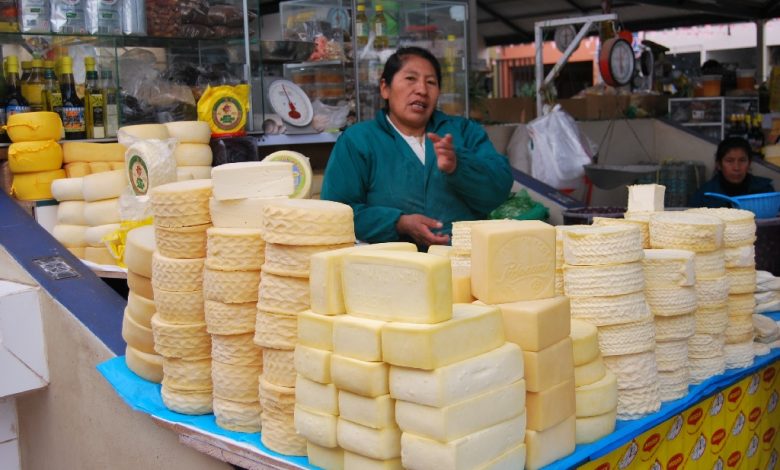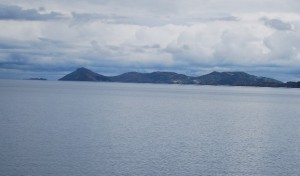Cheese and Place in Ttio Market

Like a wall of butter-yellow bricks, congealed light, cheese glows on the stand in the market. Serrated like a battlement, or perhaps just a partially constructed wall the bricks in different shapes, sizes, and textures separate the world of the woman in a blue sweater and pleated skirt inside from those of us outside.
Only some words and labels cross the line. Neither bullets nor arrows, the words sound and bring the two sides together in common identity and purpose.
“Good morning casera.”
“Good morning casero”
“What kinds of cheese do you have here?”

“Almost all of it is paria cheese, though I do have some mantecoso (buttery) cheese and a little bit of queso fresco (fresh cheese).”
“Where is it all from, casera?”
“Most of it is from Ayaviri, though some is from Cuzco and I even have a little bit of mantecoso from Peru’s north, from Cajamarca, casero. All these paria just look different because they are from different cheese-makers, but they are all from Ayaviri. Here try some of this paria.”
She lifted half a block that was yellow on the outside and bright, clean white inside. This is the white that is so symbolically important from Inca times to now, especially when it is squared with a fresh cob of Cuzco’s giant white fresh corn. Or in the morning when a wedge of cheese often accompanies a mug of hot herbed tea or coffee. Like a wedge of concentrated sunshine, it is lifted to the mouth to be nibbled before being chased with a sip of steaming warmth, the hopes for a good day to come.
We lifted the slices from off her long, wide knife. It was firm, just a bit tangy, and well salted, like the way Andeans seem to like their cheese.
Paria is a variety of what is called queso andino, or Andean Cheese. The variety goes from north to south, through many countries, along the twined spine of the high and very rugged Andes mountains. In Peru, on the northern end of a broad, grassy and high plateau that stretches the two ranges apart paria is made.
This is not too long before the road rises to the relatively low pass called La Raya and begins to plunge downward to Cuzco and even further down to Machu Picchu. On the road surrounded by valleys that look like they flow with waves in an ocean of grass, Ayaviri is squat and huddled, but old and vital.
From Cuzco’s temple of the Sun a ritual path called a ceque goes through here to end in the place where the sun is born each morning, just as the Incas were, coming out of a crag, on an Island in the massive Lake Titicaca. From off this ancient pilgrimage line, in the node of Ayaviri, our casera, the cheese vender, buys the cheese and brings it to Cuzco.
But it is so much more than just cheese. Filled with the taste of terroir, the landscape on which the cattle roam and in which the cheese is made, the bricks also carry the meaning of place, this place so different from the narrow-ish and lower valleys by Cuzco, It is from that ancient ocean of grass near the largest lake in South America. Not only does the sun rise up from that crag in the lake each morning but it is said that the first couple, the Adam and Eve, Manco Capac and Mama Ocllo were called out of the rock by the great maker Ticsi Viracocha, and then after scoring the rock around marched down the pilgrimage line to Cuzco, the holy city, where they founded civilization, the Inca Empire.
That is all part of the taste of this cheese and its terroir. But further, it is called paria after a Quechua root “para-”. Here it refers to the drops of whey that fall from the raw cheese when it is squeezed in cloth and pressed. When the place suffix –mu (from there to here) and the verb suffix –y are added the word is “paramuy”, to rain.

In its name, the cheese is associated with drops like rain, that also arguably come from the high mountains and off Lake Titicaca, which was one of the favorite haunts of the great thunder hero / god Thunupa.
Though the cheese comes from the Spanish animals, cows, they have been made native by locating them in a geography of this big story of creation, fertility, and civilization. As a result, paria cheeses have value as gifts when one travels. They carry pieces of place with them as gifts.
This is so much more than terroir as simple taste. In the Euroamerican usage it is as if our casera’s knife had done more than slice off the cheese but had sliced everything else off from around it, leaving it as some Western thing so that the only place landscape or even just place could be known is concentrated inside the object. But our casera’s knfe doesn’t do that. Instead it slices so that droplets redolent of rain and grass, and the light of the sun’s pilgrimage shine off her knife and lift from it to our mouths.
Paria cheese has been made for a long time on the grasslands around Ayaviri where people grow potatoes for sustenance, but also herd. However, some forty years ago, after the large herding estates were removed from individual hands in the Agrarian Reform, administrators brought in Brown Swiss cattle to mix with the local Creole breed.
Then the area of Ayaviri was one of the hardest hit by violence in the civil war stemming from the Shining Path, Maoist guerrilla movement of the eighties. People and livestock were destroyed in the guerrilla’s war against the modern state. But the people of Ayaviri fought back, strongly, until the guerrilla was pushed back over the mountains to the valleys where it originated, past Cuzco in Ayacucho.
After the war non-governmental development agencies sought to help the farmers, whether individuals or on cooperatives, to improve and modernize their artisanal cheese production with quite some success. Paria has survived and improved, both as product and brand, to be known throughout Peru.
It competes with industrial production from the large milk companies of the lowlands that make more international styles of cheese that are terroir-free, such as edam, gouda, mozzarella, and parmesan. Most of these names refer to a place, such as the cheese town Gouda in Holland that, despite windmills and canals, with its massive cheese market in its main square it could be a sister to Ayaviri.

But Gouda cheese, was lost to the town and became a style of cheese making known internationally as a fixed, international product. In the United States, and much of the developed world, those international, context free cheeses dominate sales. But in Peru, the artisanal market, though threatened, still holds its own.
For the industrial cheese we would have to go to the nearby supermarket called Mega. In the neighborhood market, our casera only has artisanal cheeses, filled with place and meaning.
“Casera, give us this block of paria cheese, please.”
She lifts it, places it in a plastic bag, and we give her some money, before taking it home to share in the evening with friends and family over a hot drink.
Glossary.
Casera / casero means someone involved in a buying and selling relationship. Often these ties are long lasting and mutually sustaining.




